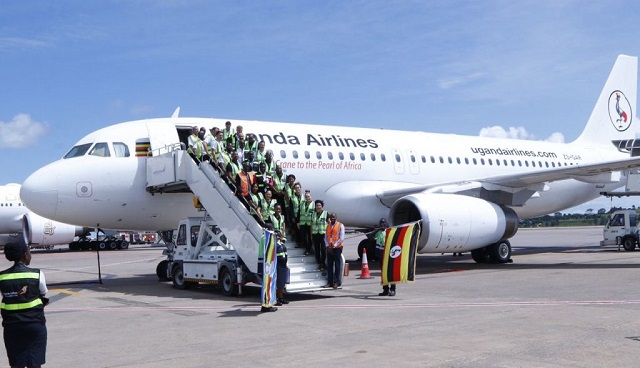
Balancing route efficiency on a tight budget
Kampala, Uganda | THE INDEPENDENT | As Uganda’s national carrier, Uganda Airlines, celebrates a shortterm wet lease agreement of an Airbus A320 airliner with Global Airlines of Johannesburg, South Africa, some commentators appear bent on dampening the excitement.
While announcing the deal on May 13, Uganda Airlines said the A320 will enhance its operational efficiency as some of its aircraft proceed on scheduled maintenance. The airline operates a fleet of six aircraft including four CRJs and two A330s.
The aircraft will support Uganda Airlines in maintaining schedule integrity during the period of scheduled maintenance of some of the CRJs. As a wet-leased aircraft, the Uganda Airlines A320 comes with its pilots and cabin crew.
It will operate on the Johannesburg, Kinshasa, Nairobi, and Lagos routes.
“Leasing this A320 is intended to ensure that our customers continue to enjoy the unparalleled service that we have become known for and add flexibility to our operations,” said Uganda Airlines CEO Jenifer Bamuturaki.
“We are delighted to announce this partnership with Global Airlines, which will support our operations at a critical juncture in our development. We have seen significant growth in demand on a number of our routes, which has introduced certain pressures on our operations.”
The leased airliner belongs to the A320 family which is the highest-selling airliner in the world. It is mid-range narrow body aircraft, featuring a wider single-aisle cabin and larger overhead bins.
Its cargo hold can accommodate unit load device containers, a feature usually reserved for wide-body aircraft. The aircraft is a 160-seater, with a twoclass cabin featuring 12-business class and 138 economy seats, according to Uganda Airlines. It also offers increased capacity for passenger baggage and cargo.
Oldest active Airbus A320
Despite the Uganda Airlines positive outlook, a story has appeared under the title “Uganda Airlines Is Now Using The World’s 2nd Oldest Active Airbus A320”.
The story by Flying Simple, an aviation digital news outlet, notes that it is challenging to make an airline work anywhere, and doubly so in Africa, a continent littered with innumerable dead airlines and others defying gravity by hanging on. It calls Uganda Airlines, a “tiny and troubled” airlines which possibly has the world’s most extreme difference in seat capacity.
“It has four CRJ900s and two A330-800s, the latter a vanity project – precisely what isn’t needed,” it says. According to it, the equipment gauge gap has been bridged, at least temporarily, by the arrival of the wetleased A320.
It says, however, “the leased A320 is not just any ubiquitous Airbus narrowbody; that’d be too easy. Instead, it is the world’s second-oldest active A320”.
It says the ZS-GAR registered A320 leased from South Africa’s Global Aviation is 35.1 years old and was the 53rd A320 built. It is surpassed by JY-JAC, with Jordan Aviation, which still flies. It was the 29th A320 built. It says ZS-GAR was delivered new to the USA’s Braniff in 1989 as N902BN. After flying for America West, US Airways, and American (all as N621AW), its U.S. flying ended in 2013, and it entered Global Aviation’s employ in 2016. Its most recent gig was with South Africa’s Lift. Size-ways, the story says the A320 intentionally fits between the carrier’s CRJ900s and A330s in size.
The story says the ZS-GAR has 160 seats: 148 in economy and 12 in business. “Unfortunately, while Uganda Airlines reported a 160-seat layout, it stated 138 economy and 12 business seats. The media dutifully reported this without question,” the story says.
Wet-leasing challenges
It adds that wet leasing, which includes aircraft, crew, maintenance, and insurance, is always expensive – more so in Africa. Generally, sub-Saharan carriers have limited choice and pay higher rates from wet lease operators (and lessors generally), partially because of heightened risk.
“Thus, it is a short-term solution,” the story says.
Uganda Airlines says ZS-GAR will be flown for six months. Flightradar24 shows that it was delivered from Johannesburg to Entebbe on May 9 and started carrying passengers from Entebbe to Kinshasa on May 14. As of May 16, it had thus far only flown to/from Kinshasa, although Johannesburg will also be an important route. It will occasionally fly to Nairobi and Lagos.
Upcoming aircraft maintenance is seemingly part of the reason for the A320. Nonetheless, it will also help with route performance, replacing the CRJ to Kinshasa and Johannesburg and transforming economics (subject to the lease rates).
The A320 will provide more than double the number of seats than the CRJ900 (let’s hope most are filled) and much more bag space. It will mean no payload restriction, significantly improving revenue opportunities and overall performance.
Using it to Johannesburg will also benefit the many passengers who continue to Mumbai while overcoming Johannesburg’s hot and high conditions, which reduce takeoff performance.
The freed-up CRJ900s could be used elsewhere, although the apparent maintenance reason for the A320 may prevent this. It will be interesting to see what happens after six months; will it just return to normal?
Boeing recently met Uganda’s president; it is always profoundly concerning when the airline is bypassed, even if it is governmentowned. While Boeing freighters and widebodies are nonsensical for Uganda Airlines, it probably does need mid-sized equipment. Wet leasing the A320 enables the carrier to see how it performs.
 The Independent Uganda: You get the Truth we Pay the Price
The Independent Uganda: You get the Truth we Pay the Price



